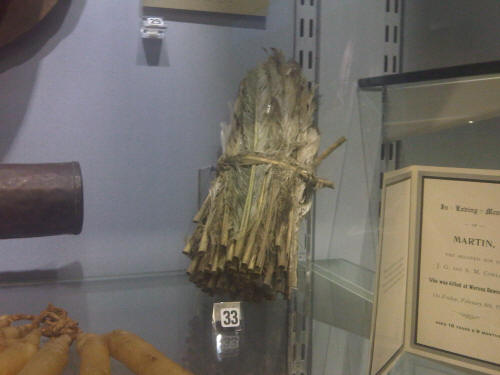|
|
| home | features | exhibitions | interviews | profiles | webprojects | gazetteer | links | archive | forum |
|
Alice Herrick and Hadrian Pigott on Exquisite Trove, Two-headed pigs and Swiss Commutators Interview Rupert White
RW How did
the Exquisite Trove show at Newlyn come about? Will it
be similar in concept and appearance to the Walsall
show? The exhibition at Newlyn will include most of the collection from the Walsall show, with a few additions of artist's curiosities and of course artefacts selected from many West Cornwall museums. The term Exquisite Trove was coined to combine the spirit of the Surrealist's game Exquisite Corpse with the depth, wonder and sense of discovery of a 'treasure trove'. The exhibition is essentially in the style of cabinets of curiosities, but with a fresh title that also allows for a more playful and less controlled curation process. The curation occurs in the choice of participating artists (those who find the 'door' to The House of Fairy Tales) and the juxtapositions and relationships made within the display of artefacts.
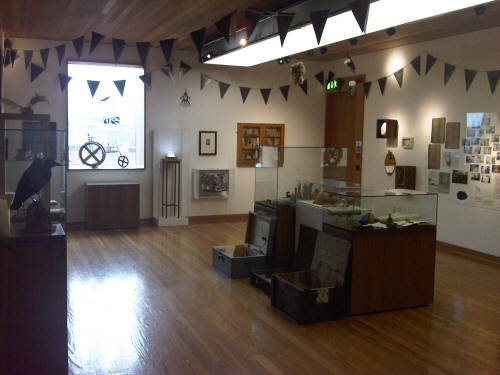 I
understand Cornelia Parker, Tim Shaw and Alex Smirnoff
have been, or will be involved. How have you shared the
work? I
understand Cornelia Parker, Tim Shaw and Alex Smirnoff
have been, or will be involved. How have you shared the
work?
HP This
show has been a collaborative endeavor from the
start. It was through my involvement as a
contributing artist to an earlier incarnation of
'Exquisite Trove', and even earlier discussions
instigated by Blair Todd at Newlyn Gallery about
creating an exhibition somehow to do with the
collections in the West Cornwall museums, that the
idea of interleaving the two 'collections' came
about.
Bringing together the collection of artists' objects
is the labour of Alice Herrick, and it does seem to
be to be a labour of love in the best way. Alice's
interest, openness and enthusiasm for art, artists,
creativity and community is inspiring, and I feel
curmudgeonly in comparison.
Working tenaciously and calmly at the other end,
Blair Todd and the Newlyn Gallery have been bringing
all the museums on board and sorting out the
logistics of museum visits, loan forms, display
cases and so on.
The selection of objects from the museums is the fun bit of course. Blair, Alice and I have visited all the museums ourselves, making contact with the directors and curators, and working up the idea of what and how the show might be. But now the selection of items for the exhibition is being done by Alex, Cornelia, Tim and myself. We had hoped to have artist Anne Hardy select for us too, but sadly she has had to pull out due to other pressures.
We wanted a diversity in the selecting artists;
different art, different experience, different
minds. The hope is to unearth the unexpected. I
only see what I see when I go round a museum,
and this part of the process is about being taken
back to a display case and have something incredible
pointed out. It's about being made to look again.
This is what we are engaged in now; taking the
selecting artists around the museums, and seeing
what comes up.
AH The selected artefacts will be merged into the existing Exquisite Trove collection whilst the show is at Newlyn. The museums will hopefully benefit from the publicity and discussions arising from their involvement with the gallery...
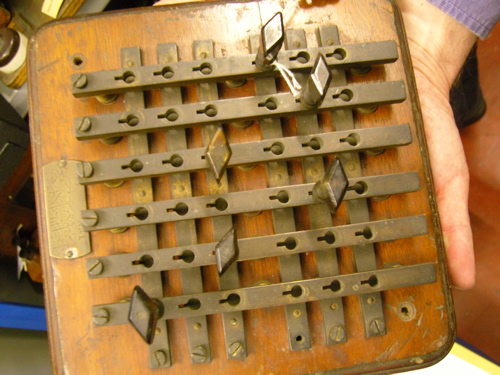 Tim
and Alex, as well as you Hadrian, are living in
Cornwall. Has Cornelia spent some time down here too? Tim
and Alex, as well as you Hadrian, are living in
Cornwall. Has Cornelia spent some time down here too? AH Cornelia is due to visit Cornwall in June to select pieces from two museums. Cornelia was chosen due to her support, as an artist, of The House of Fairy Tales (she has a print in our portfolio), but mainly because her own art practice 'allows the viewer to witness the transformation of the most ordinary objects into something compelling and extraordinary'.
Thinking about
the objects from local museums: are you able to give us
a taster of the kinds of things that you've unearthed so
far?
AH Some peculiar artefacts including a bundle of old feathers which initially appeared to have a possible link to witchcraft, but transpired to be used as dynamite holders for tin mining. A moustache cup, an egg within an egg, a skirt lifter, a mummified plague rat, a two-headed pickled pig, a walking stick made from a Narwhal tusk, a trap for three mice and an astounding amount and variety of many more artefacts! It will be fascinating to see what is selected to come to the gallery in July.
HP There
is so much stuff!
I went to Porthcurno Telegraph Museum yesterday. It is a startling place, full of incredibly clever machines from the pre-digital age. What inventiveness! It's dusty history in some ways, but Porthcurno valley remains the site of four fibre-optic submarine cables now, so the museum retains a relevance and almost hums with communications both past and present. 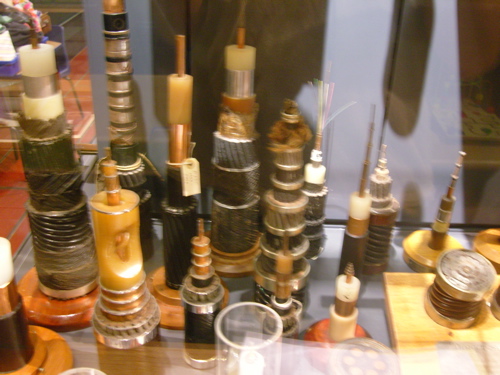 From
this museum I hope to include a piece of brass
apparatus called a Swiss Commutator (above left). It
looks like a board game - a travellers chess set -
or something, but as you might find it in a dream
where the rules have changed and you no longer know
how to play. From
this museum I hope to include a piece of brass
apparatus called a Swiss Commutator (above left). It
looks like a board game - a travellers chess set -
or something, but as you might find it in a dream
where the rules have changed and you no longer know
how to play.
The one we might have in the show is from the museum's Store - technically it's the same concept and would have done what a commutator needs to do, but its design is different and it has a small brass plaque with Arabic writing on it that is yet to be translated or deciphered by the museum. It turned out to be mislabelled too, which caused Alan Renton the museum's curator to scratch his head, but for us that's all good! There are a lot of examples of the submarine telegraph cables themselves, in cross section and in linearly dissected form. Again, it's undeniably impressive engineering, and a tangible demonstration of 100 years or more of human resourcefulness, inventiveness and enterprise. The whole industry was dedicated making the system work without fault or breakdown - what use a dead line? A problem with a submarine cable 1000 miles across the Atlantic, and 2 miles down was a problem indeed. The museum has some examples of damaged cable - four crushed inches in a 2500 mile long steel thread, cut out and repaired, and the offending section kept as a memento and as a guide as to how to do better. For me these things are very powerful, and its the headache inherent in the object that gets to me. This is interesting, because it leads onto another aspect of what we have been finding - it's industry humanized in a way; failure and frailty running hand in hand with achievement. And then there are other things that are just, well, mad genius or desperate invention - an electric plug made out of bits of wire and ship's biscuit! Seeing is believing...and believing is to unravel an explanation or invent a plausible back-story for these things.
AH There will be a variety of old and new cabinets filled with small
objects, larger floor based and wall mounted pieces as
well as things suspended from the ceiling beams. The
display will be rich and playful as at Walsall. We will
make the 'white cube' sing and dance whilst allowing for
slow contemplation of the show!
HP Helston
is a Folk Museum in its best sense - it's of and by
the people. Other contributing venues like Geevor
Tin Mine Museum are technical or industrial
museums. But whatever, its humanity, a quality of
being human that comes out. This will be the same
whether the objects in the show are from the museums
or from the artists. If there is a confusion as to
where some of the objects come from, art or artefact,
then that's fine.
I don't think many of the contributing artists' work is folk art, and that's not the scope of this show. The artist's objects are very consciously made or selected and represented. There is little innocence here, which is not to say that the items presented are not genuine in spirit. The artist's contributions have a relaxed feel to them I think, but this doesn't mean that the objects are not personally valuable and important. 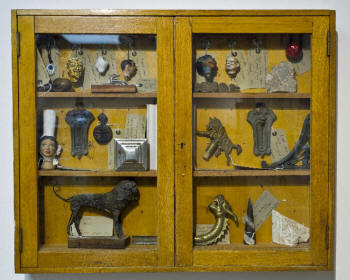 Innocence
in the museum objects is again a slippery notion.
In some cases there is a simplicity and basic
ingenuity to an object and the job it had to do, and
this seems very apparent in many agricultural or
fishing industry tools or artefacts. But at the
same time, by today's standards it is apparent that
the actual daily work conditions of people using
these tools was very harsh, whether that was a
battle with the elements or with employers. At the
Telegraph museum, its clear that the whole
communications technology was driven by the needs of
Empire building and military conquest. That's where
the money came from for investment in such a high
risk business. The benefits to domestic society
come on later, but we don't think of culpability
when we call friends in the USA for instance. Innocence
in the museum objects is again a slippery notion.
In some cases there is a simplicity and basic
ingenuity to an object and the job it had to do, and
this seems very apparent in many agricultural or
fishing industry tools or artefacts. But at the
same time, by today's standards it is apparent that
the actual daily work conditions of people using
these tools was very harsh, whether that was a
battle with the elements or with employers. At the
Telegraph museum, its clear that the whole
communications technology was driven by the needs of
Empire building and military conquest. That's where
the money came from for investment in such a high
risk business. The benefits to domestic society
come on later, but we don't think of culpability
when we call friends in the USA for instance.If there is one word to sum up the things in the exhibition it is wonderment. AH It is a celebration and exploration of the human desire to collect and tell tales with objects and images that reflect our personal histories and a fascination with the imagined lives of others. It is a non-hierarchical display which allows artists to reveal something about themselves beyond the usual context of art and art exhibitions. Some of the objects on display have been loaned by artists' children which reflects the ethos of The House of Fairy Tales as an environment for all ages to play together.
|
|
|

